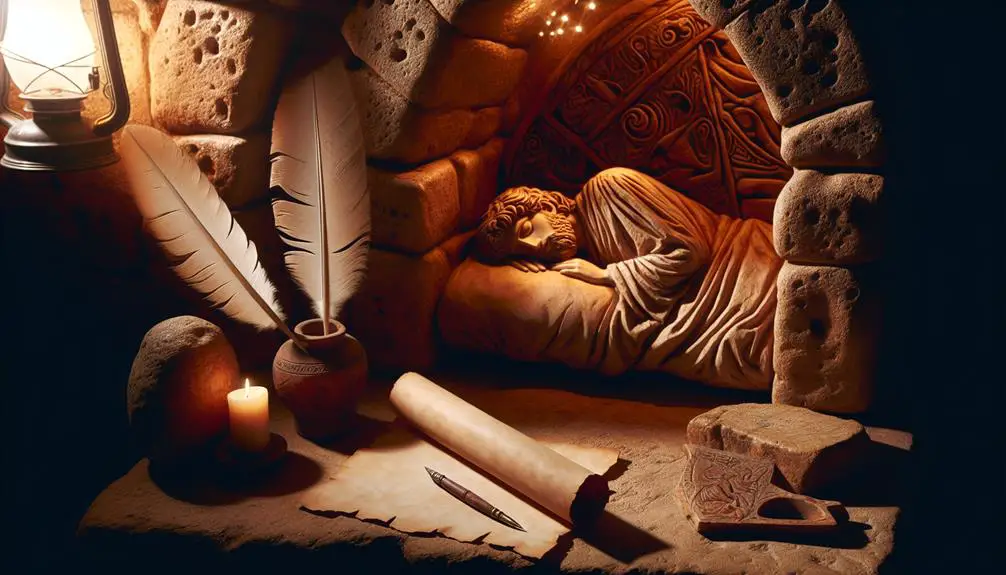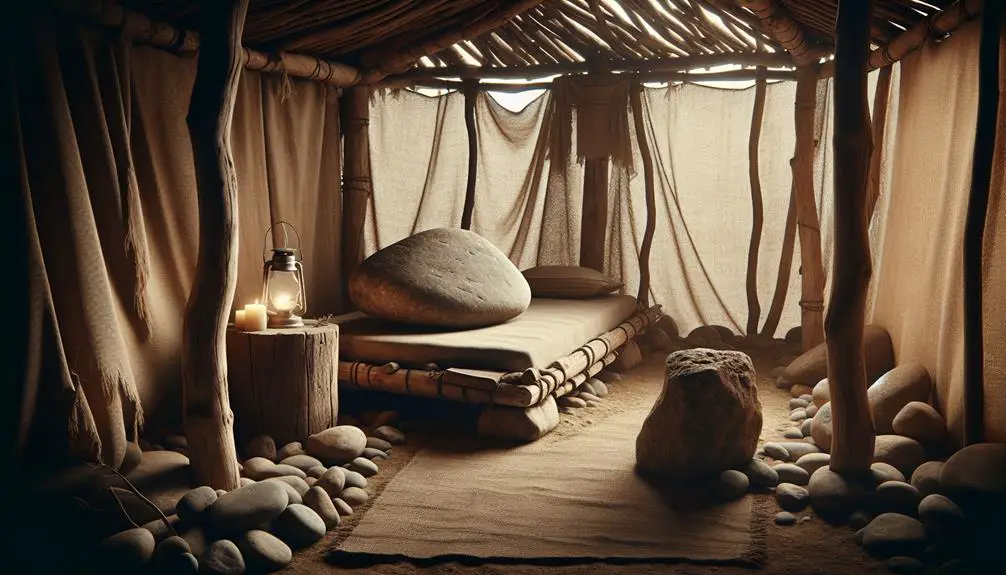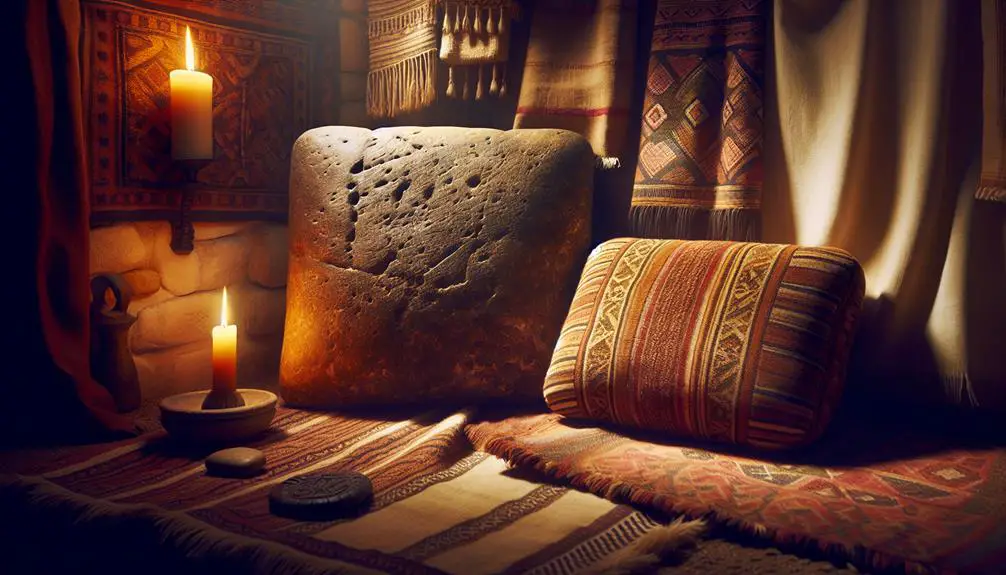Witness the unexpected spiritual and cultural dimensions of pillows in biblical narratives, revealing layers of faith and tradition.

Pillow in the Bible
In exploring the intriguing references to pillows within the biblical narrative, one is drawn into the multifaceted roles these seemingly mundane objects play. From Jacob's dream at Bethel, where a stone pillow becomes a pivotal element in a divine revelation, to their symbolic representations of rest and consecration, the occurrences invite a deeper examination of their spiritual and cultural significance.
Furthermore, the historical and contextual backdrop of pillows in ancient cultures enriches our understanding of their place in sacred scriptures. This exploration not only uncovers the layers of meaning behind biblical mentions but also beckons a closer look at how such details contribute to the broader tapestry of faith and tradition.
Key Takeaways
- Pillows in the Bible symbolize divine revelation and prophetic dreams.
- They represent familial intimacy, warmth, and nurturing in domestic settings.
- Pillows are associated with spiritual significance, indicating trust, divine protection, and favor during rest.
- The evolution and cultural significance of pillows highlight their role in wealth, status, and spiritual practices in ancient cultures.
Jacob's Dream at Bethel

In the pivotal narrative of Jacob's Dream at Bethel, as recorded in the Book of Genesis, the use of a stone for a pillow becomes a profound symbol intertwining the divine with the mundane. This choice of stone selection for repose is not merely incidental or a matter of convenience but laden with theological and symbolic significance. The narrative positions Jacob in a liminal space, at the cusp of sleep and wakefulness, where the earthly and the heavenly realms intersect. The stone, typically emblematic of the harsh and unyielding aspects of the natural world, is transformed into a point of contact with the divine.
The dream interpretation in this context extends beyond mere analysis of subconscious thoughts into a divine revelation. Jacob's vision of a ladder reaching to heaven, with angels ascending and descending, signifies a bridge between God and humanity, with the stone pillow serving as the literal and metaphorical foundation of this encounter. This moment of divine intersection is further emphasized by God's promise to Jacob, which underscores the covenantal relationship between them.
The choice of a stone also speaks to themes of permanence and memorialization within the narrative. After waking, Jacob anoints the stone with oil, consecrating it as a pillar—a tangible reminder of the divine presence and promise. This act imbues the stone with a commemorative function, transforming it from a mere object of temporal utility into a symbol of eternal covenant and divine assurance.
Analyzing the stone selection and the dream's interpretation in Jacob's narrative reveals a rich tapestry of symbolism, where physical elements are imbued with spiritual significance. This interplay highlights the profound interconnection between the divine and the mundane, illustrating how ordinary elements can serve as conduits for extraordinary revelations.
Symbolism of Rest

Building upon the motif of divine encounters through mundane objects, the symbolism of rest in biblical narratives often encapsulates themes of trust, vulnerability, and divine protection. This symbolism is profoundly illustrated through the act of sleep, which, in the context of the Bible, goes beyond mere physical rest. It signifies a state of peace and reliance on the divine, even amidst potential dangers. The concept of sleep hygiene, although a modern term, finds its ancient echoes in these narratives where peaceful slumber is often depicted as a blessing or a manifestation of being in God's favor.
Analyzing the biblical portrayal of rest further reveals a nuanced understanding of human nature and its relationship with the divine. Sleep, by its very nature, places individuals in a vulnerable state. This vulnerability, when juxtaposed with the assurance of divine protection, offers a rich tapestry of faith, showcasing how trust in the divine encompasses every aspect of life, including moments of unconsciousness. The peaceful slumber of biblical figures, often in less-than-ideal circumstances, underlines the belief in a protective and caring deity who watches over the faithful.
Moreover, this symbolism extends to communal and societal levels, where the collective rest of a community or nation is depicted as indicative of divine favor and peace. Thus, the biblical narratives on rest, through the lens of sleep hygiene and peaceful slumber, offer profound insights into the spiritual and psychological dimensions of rest, highlighting its role as a medium of divine encounter and assurance.
Prophetic Revelations

Prophetic revelations in the Bible frequently serve as a conduit for divine communication, manifesting through dreams or visions during periods of rest or sleep, and offering profound insights into the divine will and the unfolding of human history. This mode of divine interaction underscores the significance of dream interpretation and the discernment of visionary symbols within the biblical narrative. The instances of prophetic dreams, often intertwined with the usage of pillows and places of rest, highlight not only the physical but also the spiritual transition from the mundane to the divine.
The analysis of dream interpretation in the Bible reveals a pattern of divine messages being delivered to key figures during critical moments in their lives and the broader historical context they inhabit. These dreams, laden with visionary symbols, require a keen understanding and interpretation to unlock the messages they contain. Joseph's ability to interpret dreams, for instance, showcases the profound impact that understanding divine symbols can have on individual destiny and national history alike.
Moreover, the symbolic nature of dreams in biblical texts serves as a mirror reflecting the complexities of human experiences and the divine plan. Through the lens of dream interpretation, the interplay between human agency and divine providence is examined, revealing a nuanced tapestry of faith, foresight, and fulfillment. The use of visionary symbols within these dreams acts as a language through which God communicates His intentions, warnings, and promises to humanity.
Consecration and Sacred Spaces

Reflecting on the profound impact of prophetic revelations communicated through dreams, it becomes essential to explore the role of consecration and the establishment of sacred spaces within the biblical narrative, as these elements significantly influence the spiritual and physical realms of existence. The concept of consecration, or the act of declaring something sacred, is deeply intertwined with the physical objects and spaces considered holy within the scriptures. This interplay is vividly demonstrated through the sanctification of temple artifacts and the use of sacred garments, which serve not only as tools for worship but also as symbols of divine presence and authority.
Sacred Spaces |
Description |
|---|---|
Tabernacle |
A portable earthly dwelling place of God, housing the Ark of the Covenant. |
Temple in Jerusalem |
A permanent sanctuary, symbolizing God's footstool on earth. |
Mount Sinai |
The site of God's revelation to Moses, including the Ten Commandments. |
Garden of Eden |
Represented as the original sacred space, a paradise created by God. |
These sacred spaces and objects, consecrated for divine purposes, were integral to the spiritual life of the Israelites, facilitating encounters with the divine and serving as mediums through which the sacred could interact with the mundane. Temple artifacts, such as the Ark of the Covenant, and sacred garments worn by the priests during worship and ritual, underscored the holiness of God's presence and the reverence due to Him. This sanctification process highlights a divine blueprint for how spaces and objects can be transformed into conduits of spiritual power and reflection, emphasizing the importance of consecration in fostering a tangible sense of the divine within the physical world.
References in Psalms

Numerous references in the Psalms poignantly illustrate the deep spiritual connection and reverence the Israelites held towards sacred spaces and objects, shedding light on their pivotal role within biblical worship and spirituality. These Psalms, often imbued with emotive language and vivid imagery, provide a window into the personal and communal experiences of faith, including the significance of sleeping comfort and the practice of night prayers.
The Psalms frequently evoke the theme of seeking refuge and solace in God, a concept that metaphorically extends to the notion of resting or lying down in safety. For instance, the assurance of sleeping comfort, under God's protection, is a recurring motif that underscores a profound trust in divine guardianship during the vulnerability of sleep. This spiritual comfort is intricately linked to the physical comfort sought through the use of pillows, symbolizing a tangible element of faith's sanctuary.
Moreover, the practice of night prayers, as reflected in the Psalms, reveals a deeply ingrained tradition of turning to God in the quiet and solitude of the night. These prayers, often a mix of supplication, reflection, and worship, signify a personal and intimate engagement with the divine, wherein the faithful seek guidance, express gratitude, or find peace before the tranquility of sleep.
In analyzing these references within the Psalms, it becomes evident that the themes of sleeping comfort and night prayers are not merely incidental but are woven into the fabric of biblical spirituality. They exemplify the holistic nature of faith that encompasses both the physical and spiritual realms, offering insights into how the ancients integrated their spiritual practices with daily life.
Historical Context of Pillows

To fully appreciate the spiritual implications of pillows in biblical times, it is essential to explore their historical origins and uses within ancient societies. Pillows, as we understand them today, underwent a significant evolution in terms of design, purpose, and material choices. In ancient civilizations, the pillow was not merely a tool for comfort but also carried symbolic meanings, often associated with wealth, status, and sanctity. The material choices for pillows varied widely, ranging from stone and wood to softer fillings like straw, reeds, and animal hair. This diversity in materials reflects not only the technological and environmental adaptations of ancient societies but also their aesthetic and spiritual values.
The evolution of pillow materials from hard to soft substances mirrors broader historical progressions in human comfort and domestic life. Analyzing these material choices provides insight into the social and economic conditions of the time. For instance, the use of luxurious fabrics or fillings in pillows might indicate a society's access to trade networks and wealth.
Modern parallels can be drawn from the historical context of pillows, particularly in how they symbolize status and comfort. Today, the choice of pillow—be it down-filled, memory foam, or synthetic—often reflects personal wealth and lifestyle preferences. However, beyond the material aspect, pillows retain a symbolic dimension, echoing themes of rest, relaxation, and sanctuary that transcend cultural boundaries. This continuity from ancient to modern times underscores the enduring human need for comfort, both physical and spiritual, highlighting the pillow's role as more than just a functional object but as a significant cultural artifact.
Pillows in Ancient Cultures

Exploring the subtopic of 'Pillows in Ancient Cultures' reveals a fascinating intersection of utility, symbolism, and cultural practices.
From the utilitarian design of Ancient Egyptian headrests to the nuanced Biblical references that offer insights into ancient sleeping habits, and the diverse uses of pillows in Mesopotamian societies, each point contributes to a broader understanding of the historical and cultural significance of pillows.
This examination not only sheds light on the evolution of pillows but also on the intricate ways in which these items were woven into the fabric of daily life and spiritual practices across ancient civilizations.
Ancient Egyptian Headrests
In ancient Egypt, headrests, serving as predecessors to modern pillows, played a crucial role in both daily life and funerary practices, reflecting the society's intricate beliefs about sleep, protection, and the afterlife. These objects were not merely utilitarian but were imbued with significant cultural and religious symbolism, often intricately carved and sometimes inscribed with protective spells.
- Sleeping posture: The design promoted a slightly elevated head position, believed to facilitate breathing and perhaps even protect the sleeper from insects.
- Artistic representations: Headrests frequently appear in tomb paintings and artifacts, underscoring their importance in daily life and in the journey to the afterlife.
- Material variety: Ranging from wood to alabaster, the choice of material could reflect the user's social status and beliefs about purity and durability.
Biblical References Explained
Pillows, as mentioned in various passages of the Bible, offer a fascinating lens through which to examine the cultural, religious, and practical aspects of sleep in ancient times. The textual references to pillows reveal more than just a quest for physical comfort; they serve as symbolic artifacts deeply intertwined with the spiritual and existential experiences of individuals.
The concept of 'stone comfort,' for instance, highlights the austere conditions under which people sought rest, emphasizing endurance and humility before the divine. Moreover, pillows in biblical narratives often facilitate critical dream interpretations, acting as conduits for divine communication.
These instances underscore the profound role that simple objects, such as pillows, played in the spiritual and daily lives of ancient cultures, transcending their mundane utility to embody deeper religious significance.
Mesopotamian Pillow Uses
While the Bible presents pillows as symbols of spiritual communication and humility, the use of pillows in ancient Mesopotamian societies offers a compelling contrast, shedding light on their multifaceted roles in daily life and religious practices.
- Trade routes facilitated the exchange of pillow-making materials and techniques, enriching the cultural significance of pillows within Mesopotamian society.
- Pillows were often adorned with artistic motifs, reflecting the religious beliefs, myths, and the socioeconomic status of their owners.
- They served not only as items for rest but also played roles in religious rituals and ceremonies, indicating their importance beyond mere physical comfort.
This analysis reveals the complexity of pillows in Mesopotamia, highlighting their significance in trade, art, and religion, thereby offering a broader understanding of their role in ancient cultures.
Lessons From Biblical Mentions

Examining the instances of pillows mentioned in the Bible reveals deep spiritual and cultural insights that transcend their mere physical utility. These references, albeit sparse, are imbued with rich layers of meaning, particularly when analyzed through the lenses of dream interpretation and family dynamics. The biblical narratives often utilize the pillow not just as a rest object but as a symbolic conduit for divine communication and familial bonds.
In the context of dream interpretation, the story of Jacob's dream at Bethel, where he uses a stone for a pillow, stands out. This instance illustrates how an ordinary object, a pillow, becomes the medium through which God communicates profound promises and blessings. It symbolizes the connection between the divine and the earthly, highlighting how spiritual revelations are accessible even in the most mundane aspects of life. This narrative also underscores the belief in dreams as significant channels for divine messages, a concept deeply ingrained in ancient Near Eastern cultures.
Regarding family dynamics, pillows in the Bible can symbolize the intimacy and warmth of familial relationships. For instance, the use of pillows in a domestic setting might reflect the care and concern family members have for each other's comfort and well-being. Although not explicitly detailed in the biblical text, the underlying implication is that the care involved in providing a pillow or a comfortable resting place is a reflection of familial love and nurturing.
Thus, the biblical mentions of pillows, while seemingly trivial, offer profound insights into dream interpretation, divine communication, and the importance of family dynamics. These references serve as a testament to the Bible's capacity to imbue everyday objects with significant spiritual and cultural symbolism.
Frequently Asked Questions
How Do Modern Interpretations of Dreams Compare to the Biblical Understanding as Seen in Jacob's Dream at Bethel?
Modern interpretations of dreams, enriched by psychological theories and dream interpretation techniques, diverge significantly from biblical narratives such as Jacob's dream at Bethel. Contemporary analyses often focus on the psychological implications of dreams, emphasizing personal subconscious and emotional states.
In contrast, biblical accounts attribute dreams to divine messages or prophetic visions, highlighting a spiritual or moral lesson. This contrast illustrates the evolution of understanding dreams from a religious to a psychological perspective.
Are There Specific Materials Mentioned in the Bible That Were Used for Making Pillows, and How Do They Compare to What We Use Today?
In examining ancient sleep practices, the materials used for pillows as recorded in historical texts reveal a significant evolution to present-day standards. While specific materials are not extensively detailed, instances like Jacob using a stone suggest a symbolic aspect to pillow use.
This contrasts sharply with contemporary preferences for soft, supportive materials. This evolution reflects broader shifts in comfort, health awareness, and possibly, the diminishing of pillow symbolism in modern sleep culture.
In Biblical Times, Were Pillows Only a Luxury for the Wealthy, or Did Common People Also Use Them?
In the tapestry of ancient sleep customs, the question of whether pillows were a mere luxury for the elite or a common comfort transcends mere curiosity.
Analyzing pillow symbolism and historical sleeping habits reveals a nuanced landscape. While wealthier individuals undoubtedly enjoyed more ornate and comfortable pillows, evidence suggests that various forms of head support were utilized across different strata of society, reflecting broader cultural and practical aspects of sleep in antiquity.
How Has the Symbolism of Rest and Pillows in the Bible Influenced Contemporary Religious Practices or Rituals?
The symbolism of rest, as represented through the motif of pillows in biblical narratives, profoundly influences contemporary religious practices. This is evident in contemporary sermons that often utilize the concept of rest to metaphorically address spiritual rejuvenation and surrender to divine will.
Additionally, in various prayer rituals, the notion of rest is invoked to signify trust and faith in divine guidance, reflecting the enduring legacy of biblical imagery in shaping modern religious expressions.
Can the Concept of "Pillows" Be Found in Other Religious Texts Outside of the Bible, and if So, How Are They Similarly or Differently Represented?
Pillows, those quintessential symbols of rest and reflection, permeate religious texts beyond the Bible, embodying varied cultural symbolism.
These artifacts of comfort find their representations intertwined with deep spiritual meanings, from Hindu scriptures to Islamic texts, each offering a unique lens on divine connection and human sanctity.
Artistic depictions further enrich this narrative, illustrating pillows not just as physical objects but as vessels of profound religious and cultural significance.
Conclusion
In conclusion, the exploration of pillows within the biblical text reveals a multifaceted symbol that transcends mere rest. It embodies divine revelation, consecration, and the sanctification of spaces. Through Jacob's dream and references in Psalms, the study unveils a rich tapestry of cultural, historical, and spiritual layers.
This investigation not only deepens the understanding of biblical narratives but also invites a reevaluation of commonplace objects and their potential to convey profound theological truths. The journey through scripture, therefore, uncovers unexpected dimensions of meaning, urging a reexamination of the familiar.



Sign up